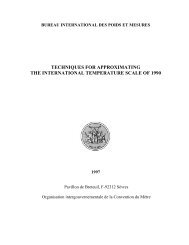On the measurement quality of UTC time transfer - BIPM
On the measurement quality of UTC time transfer - BIPM
On the measurement quality of UTC time transfer - BIPM
You also want an ePaper? Increase the reach of your titles
YUMPU automatically turns print PDFs into web optimized ePapers that Google loves.
<strong>On</strong> <strong>the</strong> <strong>measurement</strong> <strong>quality</strong> <strong>of</strong> <strong>UTC</strong> <strong>time</strong> <strong>transfer</strong><br />
- Evolution and Reevaluation <strong>of</strong> Measurement Uncertainty in [<strong>UTC</strong>-<strong>UTC</strong>(k)]<br />
Z. Jiang and W. Lewandowski<br />
Bureau International des Poids et Mesures (<strong>BIPM</strong>)<br />
Pavillon de Breteuil F-92312, SEVRES CEDEX, France<br />
zjiang@bipm.org<br />
Abstract................................................................................................................................................................... 2<br />
Notation AND ABBREVIATIONS: ............................................................................................................. 3<br />
1. Introduction......................................................................................................................................................... 3<br />
1.1 Background .................................................................................................................................................. 4<br />
1.2 Component <strong>of</strong> uA .......................................................................................................................................... 4<br />
2. Method ................................................................................................................................................................ 5<br />
3. Statistic analysis based on <strong>UTC</strong> data .................................................................................................................. 7<br />
3.1 The data........................................................................................................................................................ 7<br />
3.2 Case <strong>of</strong> <strong>the</strong> baseline NIST-PTB ................................................................................................................... 7<br />
3.3 Case <strong>of</strong> <strong>the</strong> baseline OP-PTB ....................................................................................................................... 9<br />
3.4 Discussion: how good approximations can be obtained by using an optimal Vondrak smoothing............ 12<br />
4. Re-evaluation <strong>of</strong> <strong>the</strong> uA’ for all <strong>the</strong> present <strong>UTC</strong> links...................................................................................... 13<br />
5. Conclusion ........................................................................................................................................................ 14<br />
Reference .............................................................................................................................................................. 15<br />
Annex. Configurations <strong>of</strong> <strong>the</strong> <strong>UTC</strong> worldwide <strong>time</strong> <strong>transfer</strong> networks in 2004 and at present ............................ 16<br />
Abstract<br />
Coordinated Universal Time (<strong>UTC</strong>) is computed at <strong>the</strong> International Bureau <strong>of</strong> Weights and Measures (<strong>BIPM</strong>)<br />
in Sèvres, France. The calculation is derived using data from about four hundred atomic clocks located in<br />
contributor laboratories worldwide. Numerically it is represented by <strong>the</strong> differences between <strong>UTC</strong> and <strong>the</strong> <strong>UTC</strong><br />
realization <strong>of</strong> a contributing laboratory k, [<strong>UTC</strong>-<strong>UTC</strong>(k)]; <strong>the</strong> Type A standard uncertainties <strong>of</strong> <strong>the</strong>se differences,<br />
denoted uA in <strong>BIPM</strong> Circular T, are dominated by <strong>the</strong> uncertainty in <strong>time</strong>-<strong>transfer</strong> <strong>measurement</strong>s accounting for<br />
<strong>measurement</strong> noise and random effects with a typical duration between 1 day and 30 days.<br />
The first global evaluation <strong>of</strong> <strong>the</strong> Type A uncertainty <strong>of</strong> <strong>time</strong> links was published in 2002 and introduced into<br />
Circular T 194 in 2004. Since <strong>the</strong>n <strong>time</strong>-<strong>transfer</strong> techniques have improved significantly, with <strong>the</strong> introduction<br />
into <strong>the</strong> calculation <strong>of</strong> <strong>UTC</strong> <strong>of</strong> new links based on GPS P3, All in View, PPP (Precise Point Positioning), a<br />
combination <strong>of</strong> <strong>the</strong> TW (Two-Way Satellite Time and Frequency Transfer) and GPS carrier phase (TWPPP),<br />
GLONASS and a combination <strong>of</strong> GPS and GLONASS. With <strong>the</strong>se additions <strong>the</strong> configuration <strong>of</strong> <strong>the</strong> <strong>UTC</strong> <strong>time</strong><strong>transfer</strong><br />
network has been transformed to adapt <strong>the</strong>se new developments.<br />
In this paper, we first review <strong>the</strong> Type A uncertainty <strong>of</strong> <strong>time</strong> links evaluation undertaken in 2002 and <strong>the</strong>n <strong>the</strong><br />
Type A uncertainty <strong>of</strong> TWPPP links, which are currently <strong>the</strong> most precise type <strong>of</strong> link available. By selecting<br />
one short and one long baseline where all <strong>the</strong> link types are available, we can estimate <strong>the</strong> uA <strong>of</strong> <strong>the</strong> o<strong>the</strong>r links<br />
relative to <strong>the</strong> TWPPP link and study <strong>the</strong> relationship between <strong>the</strong>se uA and <strong>the</strong> <strong>time</strong> deviation <strong>of</strong> <strong>the</strong> links. From<br />
this relationship we can estimate uA for o<strong>the</strong>r baselines where no TWPPP link is available. Finally, we carry out<br />
a global re-evaluation <strong>of</strong> uA using a method that is consistent for all 67 <strong>UTC</strong> <strong>time</strong> links.<br />
The results obtained were introduced into <strong>the</strong> generation <strong>of</strong> <strong>UTC</strong> in December 2011, with <strong>the</strong> publication <strong>of</strong><br />
Circular T 287. We recommend that such a global re-evaluation <strong>of</strong> uA should be carried out regularly – at least<br />
every four years – for <strong>the</strong> calculation <strong>of</strong> <strong>UTC</strong>.<br />
2
















